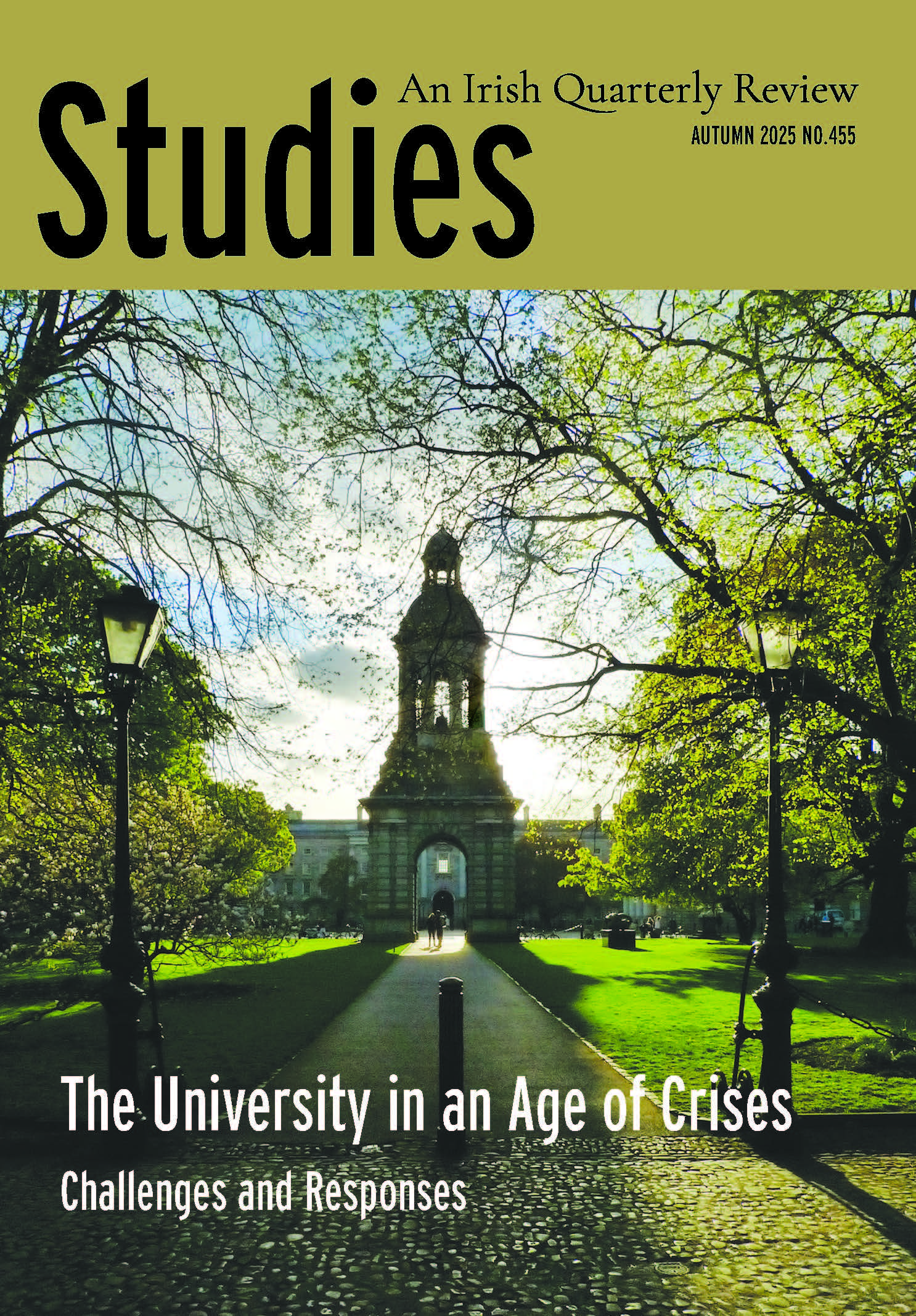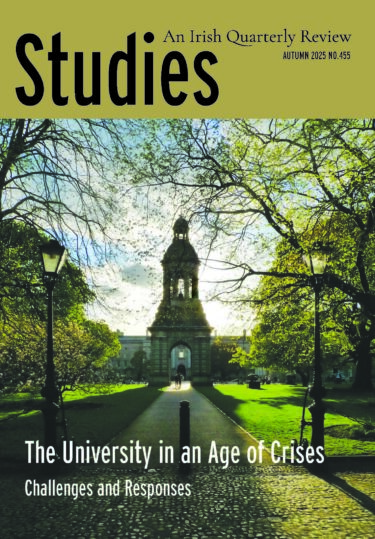Showing 1–12 of 15 results
The University in an Age of Crises: Autumn 2025, Volume 114, No 455

Full Issue
€10.00+p&p
At least since St Augustine’s account of the Earthly City in The City of God, human history has often been cast as a chain of crises and catastrophes. War, pestilence, natural disaster, famine, persecution – these were woven into the ordinary expectation of human life. The ‘state of emergency’, as Walter Benjamin put it, is ‘not the exception but the rule’. Yet for most of history, people assumed that such calamities, however devastating, would not last forever....
Read Editorial
At least since St Augustine’s account of the Earthly City in The City of God,
human history has often been cast as a chain of crises and catastrophes.
War, pestilence, natural disaster, famine, persecution – these were woven into
the ordinary expectation of human life. The ‘state of emergency’, as Walter
Benjamin put it, is ‘not the exception but the rule’. Yet for most of history,
people assumed that such calamities, however devastating, would not last
forever. There would eventually be a reprieve.
With the Cold War, however, a reprieve could no longer be taken for
granted. Perhaps for the first time in history, people could reasonably fear
a cataclysm from which there would be no return. Leaders and thinkers
across the spectrum – Pope John XXIII, Albert Einstein, Bertrand Russell,
Martin Luther King – warned of ‘unparalleled catastrophe’, ‘the abyss of
annihilation’, ‘universal death’, ‘an end to the human race’. In 1961, between
the Bay of Pigs and the Cuban Missile Crisis, after the Berlin Wall went up
and as both superpowers raced to perfect thermonuclear weapons, Robert
Lowell captured the mood in a letter to Elizabeth Bishop: there was, he
wrote, ‘a half-apocalyptic, nuclear feeling in the air, as tho nations had died
and were now anachronistic’. In his poem ‘Fall 1961’, he put it more starkly:
‘All autumn, the chafe and jar / of nuclear war;/ we have talked our extinction
to death.’
This pervasive sense of existential threat changed public discourse in
a significant way. Posterity – the fate of future generations – emerged as
effectively a new moral category. Scientific progress and political action
could no longer be judged without reckoning with their impact on those who
came after, and on the physical world that they would inherit. Humanity, it
seemed, had crossed a threshold, leaving older ethical frameworks unequal to
new tasks at hand, a crucial shift that Pope Paul VI appeared to sense in his
1971 social encyclical Octogesima Adveniens:
Man is suddenly becoming aware that by an ill-considered
exploitation of nature he risks destroying it and becoming in
his turn the victim of this degradation. Not only is the material
environment becoming a permanent menace – pollution and
refuse, new illnesses and absolute destructive capacity – but the
human framework is no longer under man’s control, thus creating
an environment for tomorrow which may well be intolerable.
The vision here of out-of-control technology goes beyond the language
of earlier papal social teaching, where technology mainly raised issues
of workers’ conditions, their rights, and the fair distribution of resources
generated by scientific progress – questions of the immediate present, that
- What the pope is intimating is that future generations have a moral
status too. Do they not impose duties and responsibilities on us, just as our
contemporaries do?
For the German philosopher Hans Jonas, whose work The Imperative of
Responsibility6 (1979) had a marked influence on the Green movement in
Germany and elsewhere, the answer is a resounding yes. What was needed,
he argued, was a ‘new ethics of responsibility for and to a distant future’ –a
‘future-oriented ethics’ absent from earlier systems, which limited themselves
to the immediate circumstances of human actions and largely ignored long-term
consequences. His case was compelling. The unprecedented power that
technology brought – ‘over matter, over life on earth, and over man himself’
– produced a radical shift in humanity’s relationship to the world. Following
his former teacher Heidegger, Jonas held that modern technology discloses
the world, including nature and even humanity, not as beings in their own
right but as resources for use and manipulation. Yet unlike Heidegger, he
insisted that this transformation opens up ‘a whole new dimension of ethical
relevance’.
In this novel situation, ethics could no longer remain anthropocentric
or neutral towards the nonhuman world. It had to confront ‘the critical
vulnerability of nature to technological intervention. The entire biosphere
has now become subject to human power, and therefore has a moral claim
on us – ‘for its own sake and in its own right’. From this, Jonas derived his
‘new imperative’: Act so that the effects of your action are compatible with
the permanence of genuine human life. Humanity has become a danger not
only to itself but to the whole spectrum of life on earth. As a result, Jonas
asserted, ‘a kind of metaphysical responsibility beyond self-interest’ has
devolved on us in this latest stage of human existence.
No one can doubt that the existential threat to both humanity and the
biosphere is starker now than ever. Even more than in the 1970s, when Jonas
was writing, this threat arises not from a single cause but from a web of
deeply interconnected factors – a ‘polycrisis’, in which ‘disparate crises
interact such that the overall impact far exceeds the sum of each part.’ Apart
from runaway technological development and the climate breakdown and
environmental degradation it has effected, we face the erosion of democratic
institutions, declining solidarity between nations, debt crises, culture
wars, and extreme wealth inequality, to name just a few factors. As Jonas
would have it, new circumstances require new thinking. Faced with this
unprecedented threat, we must be ready to revise and reshape institutions and
practices across all sectors of society. Above all, given the future orientation
of the threat, we need to rethink the very purpose and practice of education.
In Laudato Si’, Pope Francis emphasised the critical role of education in
bringing about ‘deep change’ in prevailing mindsets. Calling for an ‘integral
ecology that unites human and environmental concerns, he warned:
Our efforts at education will be inadequate and ineffectual unless
we strive to promote a new way of thinking about human beings,
life, society and our relationship with nature. Otherwise, the
paradigm of consumerism will continue to advance, with the help
of the media and the highly effective workings of the market.
Where, then, might such new ways of thinking arise? Given its institutional
depth and intellectual resources, the university holds a uniquely privileged
role in this task. Yet the path to progress here seems increasingly obstructed.
In recent decades universities have indeed developed research programs and
curricula that engage directly with global crises, and they have generated
a rich academic discourse on critical themes across multiple disciplines;
but at an institutional level they are often severely constrained by market-oriented
values and metrics. Students are treated as customers seeking a
return on investment in the shape of ‘human capital’ and ‘marketable skills’.
Universities themselves function less as communities of scholars than as
corporations, where what matters is ‘key performance indicators’, costeffectiveness,
and rankings. The internalisation of market logic undermines
their capacity to respond – as they have the resources to do – to urgent social
needs and the global common good. What is required, once again, is new
thinking.
***
Jennie Stephens’s Climate Justice and the University: Shaping a Hopeful
Future for All (2024) responds admirably to the challenge of rethinking
universities in the light of current realities. Setting the theme and the tone
of this issue of Studies, she reprises her main arguments in an essay here,
‘The Case for Climate Justice Universities: Restructuring Higher Education
for Transformative Change’. It is a bracing challenge to the university
sector to galvanise its strength and influence in the interest of the public
good, particularly by helping to move society along a path towards ‘a
more equitable, just, ecologically healthy, climate-stable future’. Stephens
recounts her own experience in universities in the United States and Ireland
– a ‘journey of learning and unlearning’. ‘Unlearning’, for her, is the critical
process of letting go of traditional assumptions and making room for ‘a
reimagining of what is possible’. She observes that Irish universities have
not yet been ‘captured by private interests’ in the way US institutions have,
allowing her to conclude on a note of hope.
Her note of hope is tempered, however, by her observation in a second
essay that capture by private interests is a growing concern in Irish higher
education. Co-authored with Laurie Reilly and Conchúr Ó Maonaigh,
‘Academic capture: Investigating Industry Funding of Higher Education in
Ireland’ argues that the Irish government has actively promoted collaboration
between the university sector and industry. Reductions in public funding of
universities have made such partnerships essential in some cases, leading,
among other deleterious effects, to the prioritisation of research with
commercial value over non-commercial research.
In ‘On Reading Jennie C. Stephens’ Climate Justice and the University’,
former president of the University of Galway Ciarán Ó hÓgartaigh offers a
response framed as a ‘retrospective self-criticism’. Drawing on his experience
in Galway, he engages with Stephens’s core themes and highlights particularly
her call to ‘unlearning’. One dimension he believes deserves more attention
is the role of students – rather than administration or faculty – in activating
the university’s transformative possibilities.
Pat O’Connor was the first female full professor of sociology in Ireland
and the first female professor in any discipline in the University of Limerick.
In an edited extract from her recent memoir, A Proper Woman? One Woman’s
Story of Success and Failure in Academia, she recounts her experience of
gender disparities and power dynamics in Irish universities. In ‘Continuities
and Changes in Gendered Practices in Academia: The Perspective of a
“Proper” Woman’, O’Connor describes how male-generated academic
discourse has long militated against women embracing public power.
In ‘Trump versus the University: Scandal or Calling to Account?’,
American scholar Joseph Rivera casts a cold eye on the Trump administration’s
interference with the independence of US universities. The universities
are not perfectly innocent victims, he argues, as their exorbitant tuition
fees effectively victimise ordinary families, and for this they must be held
accountable. He acknowledges, however, that Trump’s interference is really
just narrowmindedness and an exercise in power, and its effect is to frustrate
universities in achieving their proper educational ends.
The transformative potential of education is the subject of Ciara Whelan’s
essay, ‘Education for Sustainable Development: Ireland’s Success and the
Path Forward’. Decisive government intervention is critical, she asserts,
to ensure that education at all levels is inclusive and equitable, and that it
generates ‘positive spillovers benefiting the common good’. Ireland, she
notes, has made significant progress in integrating sustainable development
into its education system, but a challenge remains: ensuring that this
integration leads to ‘transformative outcomes’, particularly by equipping
students with frameworks for understanding how social, economic and
environmental issues are interlinked.
***
Whelan’s essay builds on a chapter she has co-written with Paul Devereux in
the fifteenth edition of The Economy of Ireland: Policy Making in a Global
Context, a core text for students of the Irish economy since John O’Hagan
first compiled and edited it in 1975. O’Hagan has edited – or more recently
co-edited – every edition of the book, giving him a unique perspective on the
highs and lows of the Irish economy over the past half-century. In ‘Reflections
on Fifty Years as Editor/Co-Editor of The Economy of Ireland’, he recalls the
many changes during that time in authors, themes, and even publishers. He
also notes how the Irish economy responded to successive policy challenges
and how these were treated in each edition.
Continuing the theme of the last issue of Studies, on Trump’s second
term, James Kelly, in ‘Language and the Question of Truth: A Critique of
Trump’s Version of Reality’, offers a philosophical analysis of language and
truth. He argues that Trump has steered his country towards authoritarianism
by manipulating language to create the ‘horrifying spectacle’ of a post-truth
world.
In ‘Key Preoccupations in the Work of English Rock Artists of Irish
Descent’, David Clare identifies characteristics shared by many rock
musicians born into Irish diasporic families in Britain, including an antimonarchic
streak and a strong pull towards Irish music, both traditional and
showband. At the end of the article, there is a QR code that links to a Spotify
playlist of the songs referenced.
The role of Robert Dudley Edwards and T. W. Moody in the
professionalisation of academic history in Ireland is recounted by Declan
O’Keeffe in ‘Irish History Writing before the 1960s: The Legacies of R. W.
Dudley Edwards and T. W. Moody’. These men laboured successfully to
bring greater scientific rigour and awareness of methodological issues to the
study of history. Among the fruits of their ‘revolution’ were two historical
societies, a journal, a radio series, a television series, a new history of Ireland,
and an Irish Society for Archives.
In ‘Reshaping European Democracy’, Edmond Grace SJ argues that the
renewal of democracy in Europe requires genuine citizen participation that
avoids being obscure or elite. He draws lessons from the Irish experience of
citizens’ assemblies, and he suggests that the democratic deficit would be
reduced by regular ‘citizens’ juries’, at local, national, and European level.
Prompted by a photo of a war grave marker in his mother’s papers,
Desmond Gibney traces the lives of two of her relatives, in ‘Two Generations
of Service Cut Short: RIC Constable Peter McRann and RAF Sergeant Peter
B McRann’. Both Peter and Brendan McRann pursued state service but saw
their careers cut short: the father by the RIC’s disbandment in 1922, the son
by death in a 1944 bombing raid.
This issue of Studies also carries the work of two renowned Irish poets, John F. Deane and Gerard Smyth.

